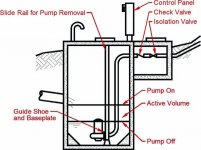Jim Nicodemus
New User
- Location
- 08048
- Occupation
- electrican
what are your views on wiring the pumps and floats that are in a septic tank I read it as class 1 div1 class
Optimal digestion will produce more co2 than methane and methane wants 5 to 15 percent to be explosive.There are those that will argue with me but I say it is not. If you have enough methane gas in a septic system to make it explosive you've got something wrong going on.
Methane has a stoichiometric air-gas ratio of 9.53 to 1 on a volume basis (the weight ratio is 17.2 to 1)Optimal digestion will produce more co2 than methane and methane wants 5 to 15 percent to be explosive.
You might want to review this thread;
Sewer wet well conduit for submerged pumps.
I am an electronic technician for the City of Lakeland Water Utilities. We are interested in finding out how to obtain an exemption in the NEC 501.15 (4) Class 1 Division 1 Boundary. Our situation is this. We have 185 sewer wet wells in the city. They have a rigid aluminum conduit that is...forums.mikeholt.com
That's an excellent point.Per 500.4 classifications are determined by design engineers and not electricians or inspectors....
Bob (rbalex) has wrapped my knuckles on occasion to remind me... I'm simply taking the liberty and beating him to the pointThat's an excellent point.
I've never seen dangerous levels of H2S in a municipal wet well. Now wastewater systems for paper mills is a whole different story. I've seen levels in tanks so high that we had to remove sludge for 3 days working 24 hours before we got the levels down far enough that we could enter the tank.[Edit Add]: H2S is also a possible component. It is toxic and has a greater LFL/UFL range than methane.
Hydrogen sulfide is a colorless, flammable gas that smells like rotten eggs at low concentration levels in the air. It is commonly known as sewer gas, stink damp, and manure gas. At high concentration levels, it has a sickening sweet odor. At extremely high levels, a person can lose their ability to smell the gas and become unaware of its presence. This condition, known as olfactory fatigue, can also occur when people have been exposed to hydrogen sulfide for a longer period of time. Hydrogen sulfide is heavier than air, so it can build up in low-lying areas and enclosed spaces.
The lower flammability limit is much more important than the stoichiometric ratio.Methane has a stoichiometric air-gas ratio of 9.53 to 1 on a volume basis (the weight ratio is 17.2 to 1)
In a septic tank, where can it go? The inlet pipe discharges underwater; the outlet pipe discharges downhill and underground, and the access hatch doesn't have much free-flowing area for methane to escape and outdoor air to replace it.You know the specific gravity of methane is like 0.55, so it really doesn't tend to collect in wet wells
None of the wet wells in sewage lift stations I've ever worked on have the inlet pipe underwater, and I've worked on lots of them. And they are supposed to have ventsThe lower flammability limit is much more important than the stoichiometric ratio.
In a septic tank, where can it go? The inlet pipe discharges underwater; the outlet pipe discharges downhill and underground, and the access hatch doesn't have much free-flowing area for methane to escape and outdoor air to replace it.

Indeed it is, technically it only requires 25% of LFLThe lower flammability limit is much more important than the stoichiometric ratio.
In a septic tank, where can it go? The inlet pipe discharges underwater; the outlet pipe discharges downhill and underground, and the access hatch doesn't have much free-flowing area for methane to escape and outdoor air to replace it.
Again NFPA 820 is "The Standard." I won't do your homework on this one, but "vents" are generally required. Of course, NFPA 820 isn't necessarily locally adopted, but if there is an employer/employee relationship in the equation, Fed or State OSHA will often have something to say under their "General Duty Clause." I only linked to the FedOSHA text, but most State OSHA's have similar verbiage.None of the wet wells in sewage lift stations I've ever worked on have the inlet pipe underwater, and I've worked on lots of them. And they are supposed to have vents
View attachment 2566473
I won't do your homework on this one, but "vents" are generally required.
they are supposed to have vents
Sorry, I misread your post.Where did I say they don't have vents? I even posted a diagram showing a "candy cane" vent
Who said anything about wet wells or lift stations? The question was about septic tanks.None of the wet wells in sewage lift stations I've ever worked on have the inlet pipe underwater, and I've worked on lots of them. And they are supposed to have vents
I just assumed he was working on a lift station of some sort. Unless it's some kind of crazy system where the pump intake is near the top, and it's pumping water up to a leach field. That would be a new one for me though. It should still need a vent to work properlyWho said anything about wet wells or lift stations? The question was about septic tanks.
Though I am a little puzzled by the presence of a pump in a septic tank. I thought they were usually gravity-fed.
